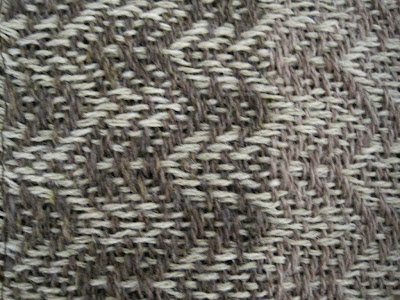One of the early tenets of weaving that was fortunately impressed upon me right from the start was the need to wash handwoven fabric before it can be considered finished. Washing not only cleans the fibres of any oils or dirt picked up during production, but washing is very important to help the fabric work as a unit instead of remaining as only interlocking threads.
A very experienced weaver on this topic is
Laura Fry. Laura has produced "Magic in the Water" and teaches workshops on wet-finishing cloth. I like how Laura has not only taught many weavers about the importance and techniques of wet finishing, but also been able to make this a part of her business.
Here are three samples of Shetland wool blankets. From left to right, they are unwashed, handwashed and machine washed.
Detailed samples show the unwashed sample as very loose and gauzy. Fabrics right off the loom are also stiff and not very soft to the touch, and they don't drape at all.
This next sample was handwashed gently as I would do for all Shetland wool blankets after fringing:
And the final sample I tossed into the washing machine with the laundry. It felted quite nicely, which would be great for a jacket or vest. However, for a blanket it's just a bit too thick. As well, the width and length were reduced.
Every single fabric I produce, whether of wool, alpaca, cotton or silk, is washed after hemming or fringing. The cloth is simply not ready to use until it's had one washing suitable for the fibres and the fabric's intended use.























